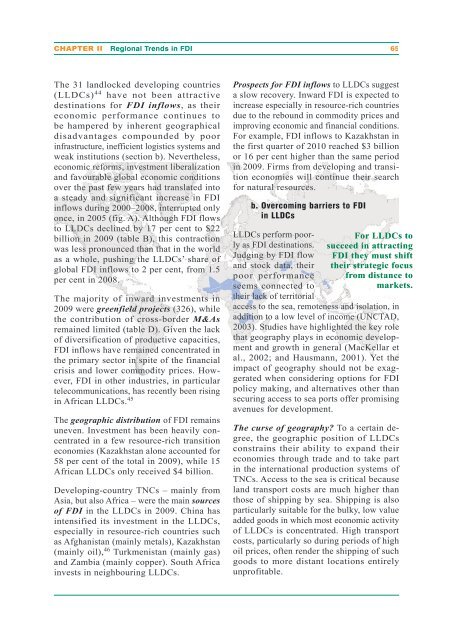UN World Investment Report 2010 - Office of Trade Negotiations
UN World Investment Report 2010 - Office of Trade Negotiations
UN World Investment Report 2010 - Office of Trade Negotiations
You also want an ePaper? Increase the reach of your titles
YUMPU automatically turns print PDFs into web optimized ePapers that Google loves.
CHAPTER II Regional Trends in FDI 65<br />
The 31 landlocked developing countries<br />
(LLDCs) 44 have not been attractive<br />
destinations for FDI inflows, as their<br />
economic performance continues to<br />
be hampered by inherent geographical<br />
disadvantages compounded by poor<br />
infrastructure, inefficient logistics systems and<br />
weak institutions (section b). Nevertheless,<br />
economic reforms, investment liberalization<br />
and favourable global economic conditions<br />
over the past few years had translated into<br />
a steady and significant increase in FDI<br />
inflows during 2000–2008, interrupted only<br />
once, in 2005 (fig. A). Although FDI flows<br />
to LLDCs declined by 17 per cent to $22<br />
billion in 2009 (table B), this contraction<br />
was less pronounced than that in the world<br />
as a whole, pushing the LLDCs’ share <strong>of</strong><br />
global FDI inflows to 2 per cent, from 1.5<br />
per cent in 2008.<br />
The majority <strong>of</strong> inward investments in<br />
2009 were greenfield projects (326), while<br />
the contribution <strong>of</strong> cross-border M&As<br />
remained limited (table D). Given the lack<br />
<strong>of</strong> diversification <strong>of</strong> productive capacities,<br />
FDI inflows have remained concentrated in<br />
the primary sector in spite <strong>of</strong> the financial<br />
crisis and lower commodity prices. However,<br />
FDI in other industries, in particular<br />
telecommunications, has recently been rising<br />
in African LLDCs. 45<br />
The geographic distribution <strong>of</strong> FDI remains<br />
uneven. <strong>Investment</strong> has been heavily concentrated<br />
in a few resource-rich transition<br />
economies (Kazakhstan alone accounted for<br />
58 per cent <strong>of</strong> the total in 2009), while 15<br />
African LLDCs only received $4 billion.<br />
Developing-country TNCs – mainly from<br />
Asia, but also Africa – were the main sources<br />
<strong>of</strong> FDI in the LLDCs in 2009. China has<br />
intensified its investment in the LLDCs,<br />
especially in resource-rich countries such<br />
as Afghanistan (mainly metals), Kazakhstan<br />
(mainly oil), 46 Turkmenistan (mainly gas)<br />
and Zambia (mainly copper). South Africa<br />
invests in neighbouring LLDCs.<br />
Prospects for FDI inflows to LLDCs suggest<br />
a slow recovery. Inward FDI is expected to<br />
increase especially in resource-rich countries<br />
due to the rebound in commodity prices and<br />
improving economic and financial conditions.<br />
For example, FDI inflows to Kazakhstan in<br />
the first quarter <strong>of</strong> <strong>2010</strong> reached $3 billion<br />
or 16 per cent higher than the same period<br />
in 2009. Firms from developing and transition<br />
economies will continue their search<br />
for natural resources.<br />
b. Overcoming barriers to FDI<br />
in LLDCs<br />
LLDCs perform poor- For LLDCs to<br />
ly as FDI destinations. succeed in attracting<br />
Judging by FDI flow FDI they must shift<br />
and stock data, their their strategic focus<br />
poor performance from distance to<br />
seems connected to<br />
markets.<br />
their lack <strong>of</strong> territorial<br />
access to the sea, remoteness and isolation, in<br />
addition to a low level <strong>of</strong> income (<strong>UN</strong>CTAD,<br />
2003). Studies have highlighted the key role<br />
that geography plays in economic development<br />
and growth in general (MacKellar et<br />
al., 2002; and Hausmann, 2001). Yet the<br />
impact <strong>of</strong> geography should not be exaggerated<br />
when considering options for FDI<br />
policy making, and alternatives other than<br />
securing access to sea ports <strong>of</strong>fer promising<br />
avenues for development.<br />
The curse <strong>of</strong> geography? To a certain degree,<br />
the geographic position <strong>of</strong> LLDCs<br />
constrains their ability to expand their<br />
economies through trade and to take part<br />
in the international production systems <strong>of</strong><br />
TNCs. Access to the sea is critical because<br />
land transport costs are much higher than<br />
those <strong>of</strong> shipping by sea. Shipping is also<br />
particularly suitable for the bulky, low value<br />
added goods in which most economic activity<br />
<strong>of</strong> LLDCs is concentrated. High transport<br />
costs, particularly so during periods <strong>of</strong> high<br />
oil prices, <strong>of</strong>ten render the shipping <strong>of</strong> such<br />
goods to more distant locations entirely<br />
unpr<strong>of</strong>itable.

















